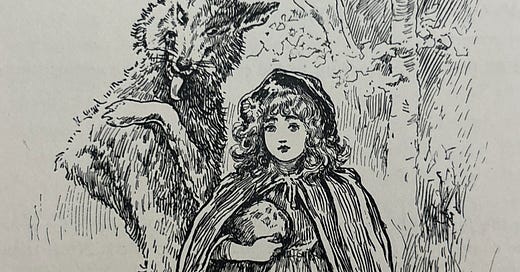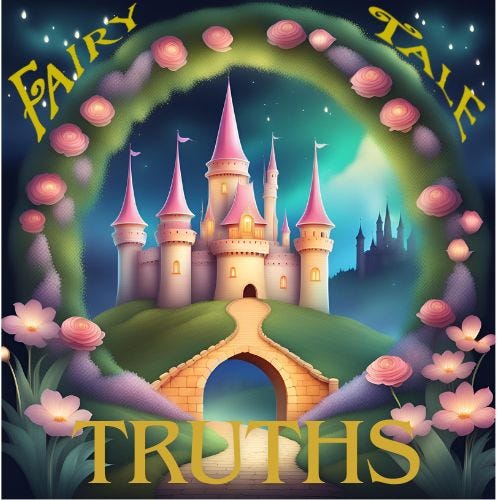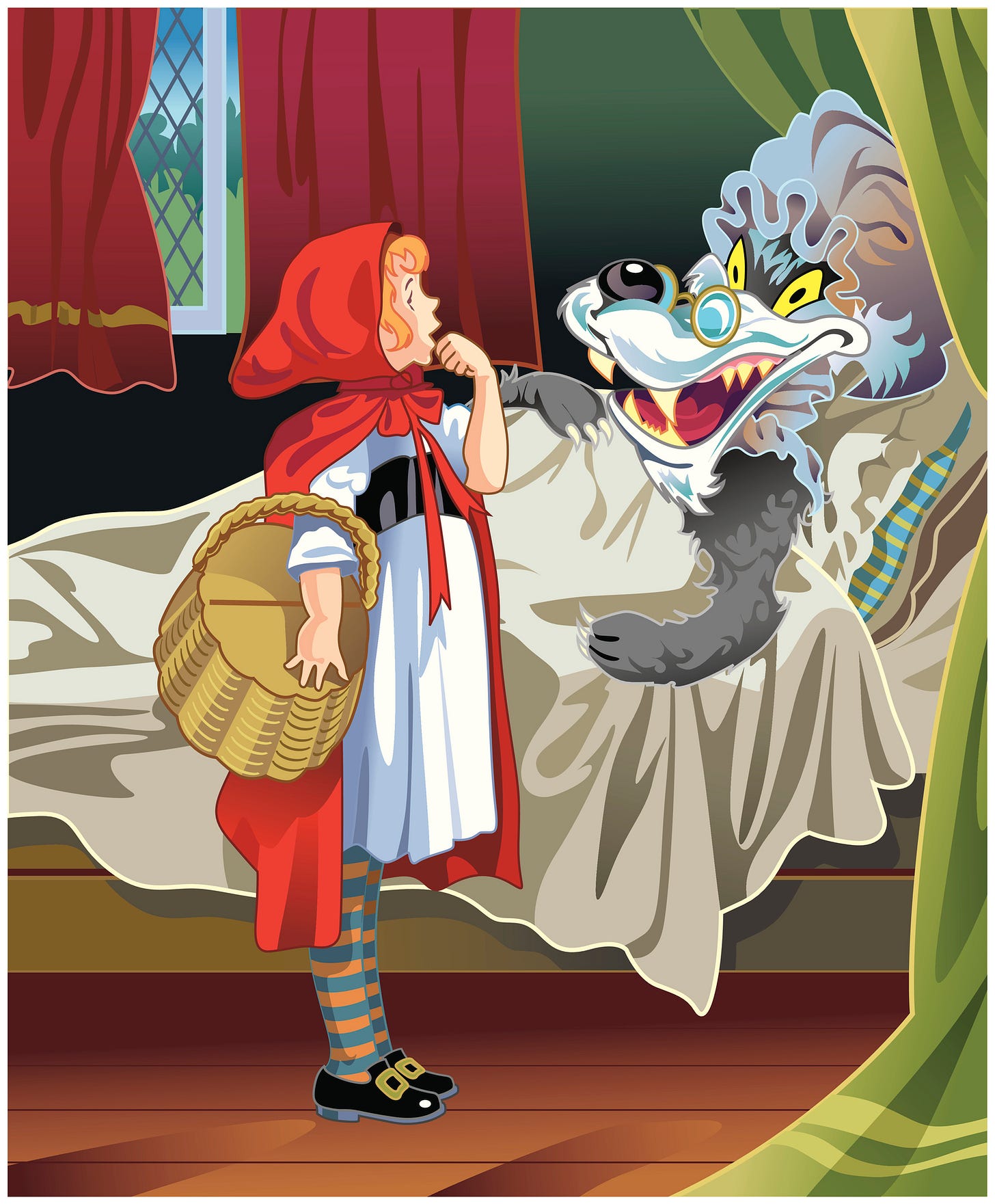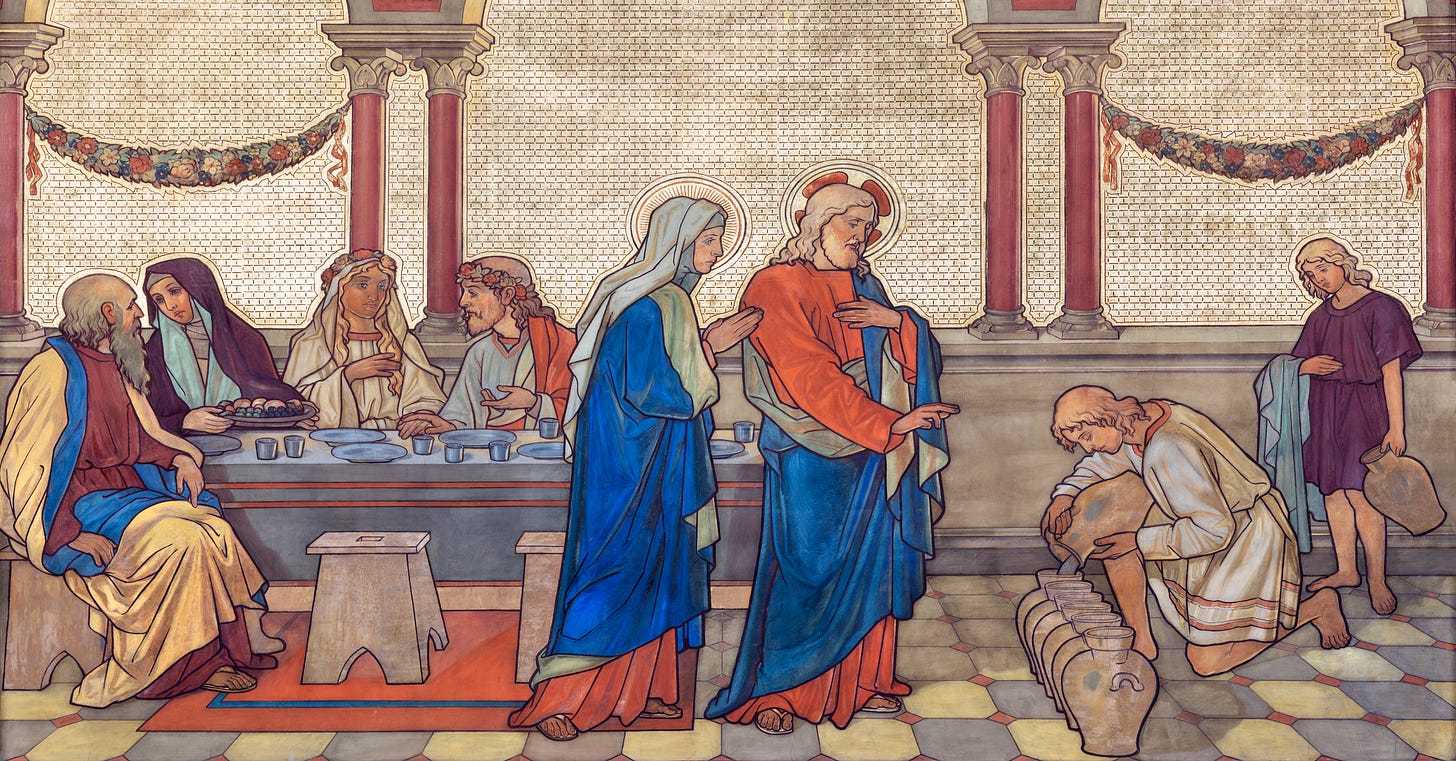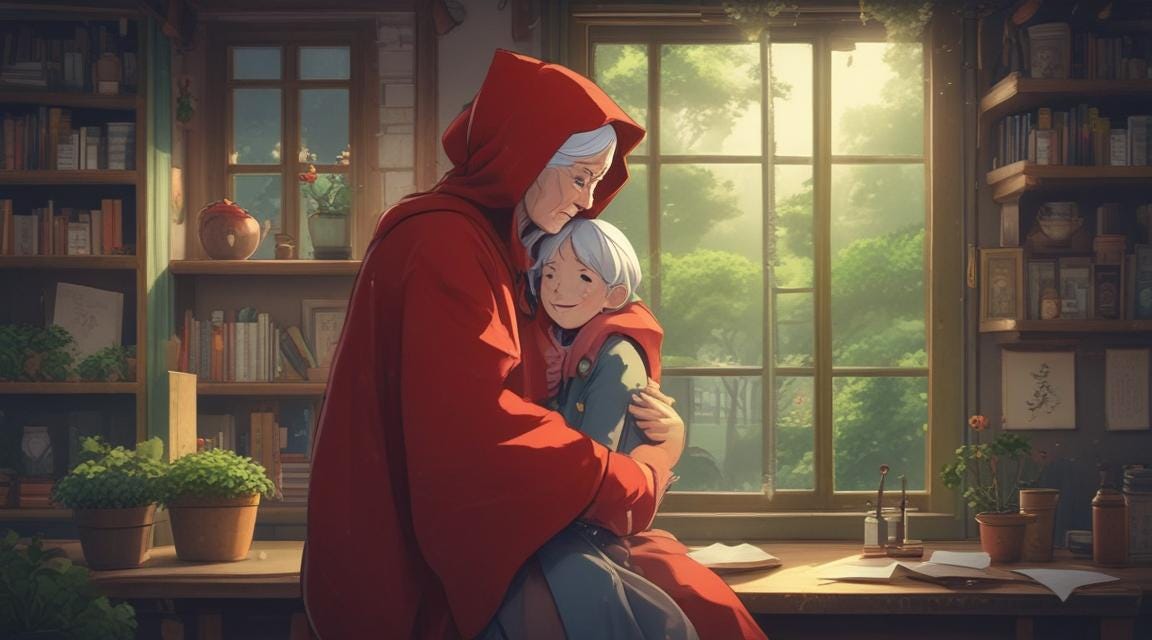Fairy Tale Truths: Little Red Riding Hood
A girl, a grandmother, a wolf and a huntsman
In keeping with the journeying, follow-the-path theme for September, the story we’ll talk about this month is Little Red Riding Hood.
This well-known fairy tale has been around for hundreds of years. It was passed on orally (spoken) and aurally (heard) for many generations before being written down by French author, Charles Perrault. The story appeared in his book Contes de ma mère l’oye (Tales of Mother Goose) in 1697.
The same story appeared again more than one hundred years later, in a collection of fairy tales published by the German folklorists, Jacob and Wilhelm Grimm. Originally called “Rotkäppchen” (German: “Little Red Cap”), the story is in their first collection of folktales Kinder- und Hausmärchen (1812–15; “Children’s and Household Tales,”) more commonly called Grimm’s Fairy Tales.1
Little Red Riding Hood also appears in the Blue Fairy Book decades later in 1889, as part of the 12-volume collection of fairy tales compiled by Andrew Lang and his wife, Leonora Blanche Alleyne. Nevertheless, it is the version presented by the Brothers Grimm that remains the most well-known.
In fact, this one little, short story has been re-written and re-presented in many different ways since its first publication. Besides the many different written versions of Little Red Riding Hood, there are also plays, movies and videos that tell the story, some in a manner appropriate for children, while others are strictly meant for adults.
So, let’s go back to the original version, as it is presented in Grimm’s Fairy Tales2, and read it closely to see what we can learn from this story by using the Four Senses.
*This story is in the public domain, and you can read it online at Little Red Riding Hood (americanliterature.com)
1. Literal Sense: What does the story say?
Here’s a quick recap of Little Red Riding Hood - short and sweet since this is a story we all know.
Little Red Riding Hood is a young girl, dearly loved by her mother and particularly by her grandmother, who gives her a special garment to wear - a red cloak with a hood. Because the young girl loves this garment so much, she is never without it, so people start calling her “little red riding hood.”
One day, her grandmother falls ill. Red’s mother sends her off to visit her grandmother with a basket of cake, a bottle of wine, and a reminder to “Set out before it gets hot, and when you are going, walk nicely and quietly and do not run off the path, or you may fall and break the bottle, and then your grandmother will get nothing.”
Little Red Riding Hood sets off but meets with a wolf just as she enters the forest. Now, Little Red “did not know what a wicked creature he was and was not at all afraid of him.” The two chat and the wolf soon learns where Red Riding Hood is going. He decides to act quickly, so as to catch both the young girl and her grandmother.
After encouraging Little Red to go off the path and gather some flowers, the wolf runs ahead to the grandmother’s cottage. There, he immediately enters, eats the grandmother, puts on her clothes and jumps into her bed.
The young girl soon appears, discovers that her grandmother looks a lot different than she remembers, and is soon gobbled up by the wolf as well. Fortunately for the grandmother and Little Red, a huntsman happens to be passing the cottage. He hears the wolf snoring loudly and enters to investigate. With some quick thinking, he realizes he can free both of the people trapped inside the wolf, so he does so by opening up the wolf’s stomach. The three then place two very large stones inside the wolf and stitch him back up, and are delighted that “when he awoke, he wanted to run away, but the stones were so heavy that he collapsed at once and fell [down] dead.”3
The huntsman, the grandmother and Little Red Riding Hood all celebrate. The story ends with a short note, saying that Red Riding Hood met another wolf at a different time, when she was again walking through the forest to visit her grandmother. But this time, Little Red is not fooled. Hurrying along to the safety of her grandmother’s house, the two hatch a plan to deal with this second wolf, and after that “Little Red Riding Hood went joyously home, and no one ever did anything to harm her again.”4
2. Spiritual Sense A - Allegorical: What does the story mean?
Little Red Riding Hood tells the story of a person who moves from the state of innocence into experience, and then undergoes redemption. When all of these elements are integrated, the person arrives at Wisdom.
This story was told, over and over, for two reasons. First of all, the natural world really was (and still can be) dangerous to young children. The forests contained many hungry animals who would certainly view a child as a good dinner. Children who wandered off the path really could lose their way and never be found, possibly dying of exposure or worse. For many people in the Middle Ages, life was “short, sharp and shocked”, and there were real consequences for young people who ignored the advice of their parents.
The second reason Little Red Riding Hood was so popular is because it conveys a real truth. It tells the listener how to journey through life, from childhood to old age, from being the young, innocent girl who leaves home and eventually, over time, becomes the old grandmother.
In fact, a close reading of this little story gives us reason to pause. We’ve probably heard it so often and seen it retold in so many different ways that it’s easy to overlook its true meaning. The story is plainly telling the listener, “Beware! There is real danger in this life!” The wolf is a real enemy. He is not kind or cute. He intends to devour Red Riding Hood when he first meets her, and only changes his mind when he hears about the grandmother, because his appetite has no bounds, and he is motivated by devouring two people over just the one. He has no regard either for Red’s innocence and youth, nor for the grandmother’s advanced age or sickness. There is no compassion, not even a hint of kindness or concern, at any time from the wolf. In fact, he should really be called The Wolf, capitalized as a proper name.
One way of thinking of the Wolf is as whatever draws us off the path, away from following Christ, whatever distracts us and makes us tarry, even forgetful. But there’s also another way of looking at The Wolf, and that is simply as Death. As the story illustrates, we will each meet Death eventually. We may be just starting out, as Little Red Riding was the first time she met the wolf. We may be advanced in age, like the grandmother, or any age in between. Death’s a certainty. But what is not certain is the disposition we will have when we do meet. That’s what the rest of Little Red Riding Hood is about.
3. Spiritual Sense B - Moral: How does the story teach us to act?
At the start of the story, the mother gives her daughter several bits of advice, some important rules to follow. “Set out before it gets hot,” is the mother’s first comment. In other words, don’t wait until some distant time in the future, when the sun is high overhead and everything is perfect, to start on the journey of following God. “Perfect” never comes, and time passes. Develop those habits of virtue and prayer practices when you are young, so they become part of you. Be awake, start now, today.
Next, the mother advises the girl to “walk nicely and quietly.” Although our modern ears may read this as an invitation to be unseen and unheard, even excessively demure, this, in fact, is a reminder to be humble. The virtue of Humility is often misunderstood as being weak, even being a victim. But Humility actually refers to being teachable, to understanding that other people might know things you don’t, and that one can learn and grow and not simply be reactive and protective. Humility is about being willing to be vulnerable and focus on others. It’s also a key to the life of discipleship.
A lack of humility will inevitably lead one off the path. Jesus said, “I am the Way,” the path, the disposition, and he also said, “I am meek and humble of heart.” (Mt 11:29) Only those who are humble can truly follow Christ. This is the third piece of advice given by the mother when she says, “Do not run off the path, or you may fall.” Seek humility. Be meek. Or, as Mary said at the wedding at Cana “Do whatever he tells you.” (John 2:5)
The last piece of advice Little Red’s mother gives her is a warning. If Red leaves the path and falls, then she will “break the bottle, and [her] grandmother will get nothing.” This is a twofold warning. If Red disobeys and leaves the path, she will likely fall. That fall will have consequences beyond the harm she might do to herself. The wine will be lost, and the grandmother will get none. In other words, Little Red will not be able to give something she herself doesn’t have. She will lose the spiritual disposition acquired from walking the path that the mother points out.5 If she gets lost in the wilderness, she’s more likely to grow wild herself. She won’t give her grandmother the wine because she probably won’t even be thinking about the grandmother anymore.
The same basic idea holds for the second interpretation as well. When Little Red Riding Hood grows elderly and becomes Old Grandmother, what will her inner life be like? If she has not spent her life eating the bread and drinking the wine, will she be loving and wise? Or will she be bitter and resentful, finding fault with everyone and everything? Breaking the wine bottle has consequences in both the short term as well as the long term, even into eternity.
4. Spiritual Sense C - Anagogical or Eschatological Sense: How does the story point us forward, to our end?
No matter what the particular circumstances are that we are born into, we all begin as children. No one is born as an adult. Because we start as young children, we all begin with a certain innocence and naivety. This is our starting point, no matter how long it lasts.
But it doesn’t take very long before we find that life is full of struggles and disappointments. In literary terms, this is referred to as the “fall from innocence to experience.” The first fall happened in the Garden of Eden, when Adam and Eve left their state of innocence behind when they detoured from the path laid out for them by God. Once they left the Garden, they got to experience all the toil and hardship that entailed. We undergo the same journey, albeit to a lesser extent.
But once we have fallen into the World of Experience, Little Red Riding Hood tells us not to lose hope! Wolves may trip us. We may lose our way, step off the path, become distracted by the sunshine and flowers and dilly-dally, losing track of time. Yes, we will even eventually be swallowed up by the big Wolf, Death.
But the huntsman walks in the woods, and he is not afraid of that Wolf.
The story tells us that when the huntsman entered the cottage, he came to the bed and saw that “the wolf was lying in it. "Do I find you here, you old sinner," said he. "I have long sought you." The huntsman is initially going to simply shoot the wolf where he lays, but changes his mind, thinking that the people inside “might still be saved.” Instead, he performs a type of cesarian operation, bringing the grandmother and Red Riding Hood back to life. The huntsman, of course, is Jesus, the slayer of death. To emphasize just how definitively Jesus defeats death, the story tells us that the “huntsman drew off the wolf's skin and went home with it.” Not content to simply leave the wolf lying there dead, the huntsman skins the animal and takes its coat home as a trophy.
In a short space, this little story tells us quite a bit about the Path of Discipleship, the Path of Continuing Conversion. It is meant to guide the listener from his or her beginning of innocence, down the twists and turns of life, even through the descent into death, promising a restoration to life by the “cake and the wine,” and the saving action of the huntsman. Little Red Riding Hood is a happy story, with a good ending. To emphasize the happy ending that awaits if the advice of the mother is followed, the story ends by saying “and no one ever did anything to harm Little Red Riding Hood again.”
Historical information comes from: Little Red Riding Hood | Story, Characters, Grandma, Moral, & Themes | Britannica
I’ll continue to use Little Red Riding Hood instead of Little Red Riding Cap, because that is what we are more familiar with.
Little Red Riding Hood (americanliterature.com)
Ibid.
This is an echo of the Parable of the Wise and Foolish Virgins in Matthew 25:1-13.


